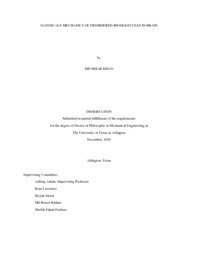| dc.description.abstract | The long-term objective of this dissertation is to link blast-induced traumatic brain injury (TBI) with multiscale, multiphysics damage evolution in the brain using experimentally verifiable computations and simulations. The short-term goal is to conduct modeling and simulation to correlate dynamic mechanical loading to damage in sub-axonal components. It is known that the interior of the brain at the macroscale (10^-1 m) is composed of two distinct components, the grey matter, and the white matter. Within the cortex, the grey matter primarily takes the form of cortical columns (mesoscale: 10^-3 m), which are six layered structures, each composed of 8-10 thousand neurons with unmyelinated axons. White matter, on the other hand, consists of the myelinated axons structured as fiber tracts, whose cell bodies are in the grey matter. Structurally, a single neuron (microscale: 10^-6 m) is composed of a soft cell body (soma), fibrous dendrite branches, and an axon fiber. Both axons and dendrites are supported by the cytoskeleton (nanoscale: 10^-9 m), which is primarily composed of neurofilaments, microfilaments, tau proteins and microtubules. As such, strain rate dependent studies are particularly important for characterizing cytoskeletal components and hence obtaining molecular level insight on neurological disorder and/or damage, such as Traumatic Brain Injury (TBI). Of all the elements of the cytoskeleton, tau protein and NF lacks understanding due to presence of unstructured portions in the structure. Due to the length scale of cytoskeletal components, they are suitable for molecular level computational studies. In this thesis, we have developed reliable predicted structures for the disordered molecules such as tau protein and neurofilaments. Then we have captured the stress-strain response of tau protein, neurofilaments, actin, spectrin, and actin-spectrin interaction model under different mechano-biological scenario.
In the first study, we have shown the effect of strain rate on single tau, dimerized tau, and tau-MT interface interaction. In the second study, we have incorporated domain and residue focused phosphorylation in tau. Therefore, this study addresses the behavior of tau according to the phosphorylated state and attempts to find out the effect of this post-translational modification. The first and second studies have successfully provided crucial insights regarding rate dependent aspects of tau, and structural and chemical response of this cytoskeletal component. In the third study, we have performed similar strain rate dependent tests on the sidearms of NF isoforms. The fourth study has taken tau and NF studies further and characterized tau and NF behavior by fitting their relaxation data to established viscoelastic models. In the fifth study, high strain rate response of actin, spectrin, and actin-spectrin interaction model have been determined.
Based on the five studies performed, we have particularly enhanced the existent computational model, which does not include all elements of axon such as tau protein and NFs. Furthermore, we have also aided the finite element modeling of axon model, as due to the inclusion of the insight and deformation aspects of tau protein and NFs it will be more realistic and comprehensive. Therefore, our study is impactful in the sense is that it will pave the pathway to develop a bottom up approach of computational axon modeling. | |


